
The Obamacare 3.8% Real Estate Tax
On January 1, 2013, a new 3.8 percent tax on some investment income went into effect. This tax was passed by Congress in 2010 with the intent of generating an estimated $210 billion to help fund President Barack Obama’s health care and Medicare overhaul plans. Understand that this tax WILL NOT be imposed on all real estate transactions, a common misconception. Rather, it may impose a 3.8% tax on some (but not all) income from interest, dividends, rents (less expenses) and capital gains (less capital losses). The tax will fall only on individuals with an adjusted gross income (AGI) above $200,000 and couples filing a joint return with more than $250,000 AGI.
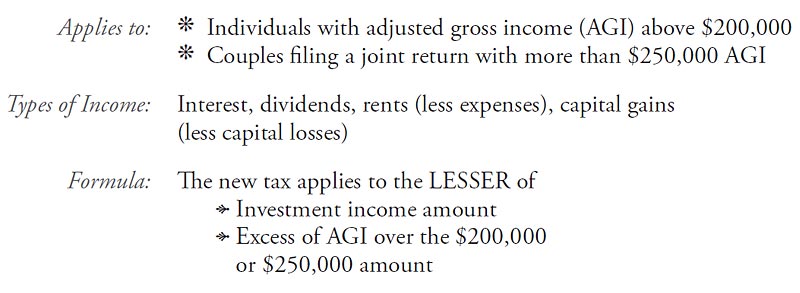
![]()
Capital Gain: Sale of a Principal Residence
John and Mary sold their principal residence and realized a gain of $525,000.
They have $325,000 Adjusted Gross Income (before adding taxable gain).
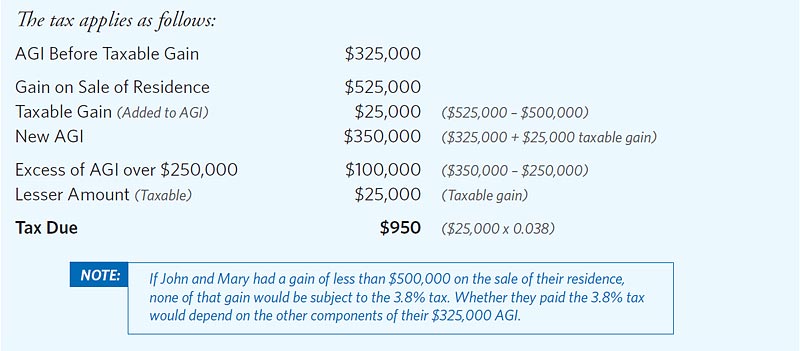
![]()
Capital Gain: Sale of a Non-Real Estate Asset
Barry and Michelle inherited stocks and bonds that they have decided to liquidate. The sale of
these assets generates a capital gain of $120,000. Their AGI before the gain is $140,000.
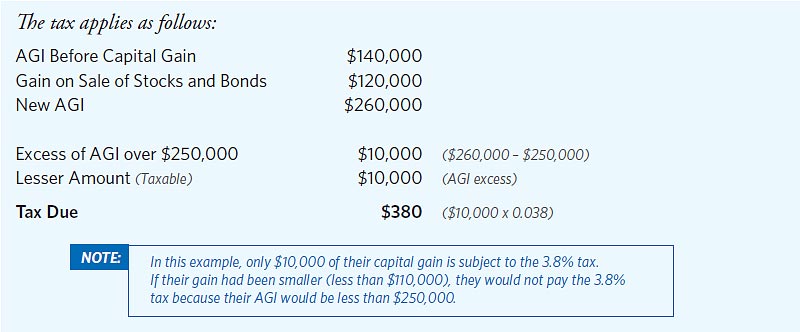
![]()
Capital Gains, Interest and Dividends: Securities
Harry and Sally have substantial income from their securities investments. Their AGI before
including that income is $190,000. Their investment income is listed below.
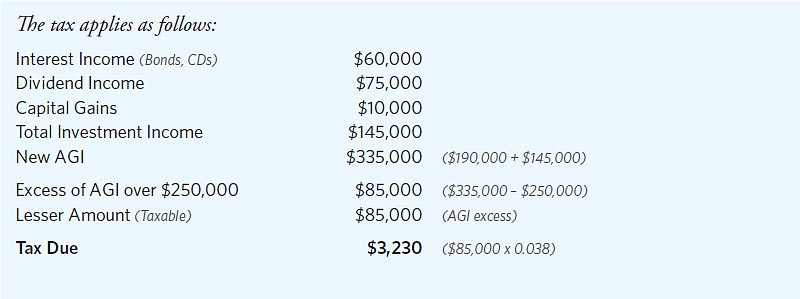
![]()
Rental Income: Income Sources Including Real Estate Investment Income
Hank has a “day job” from which he earns $85,000 a year. He owns several small apartment
units and receives gross rents of $130,000. He also has expenses related to that income.
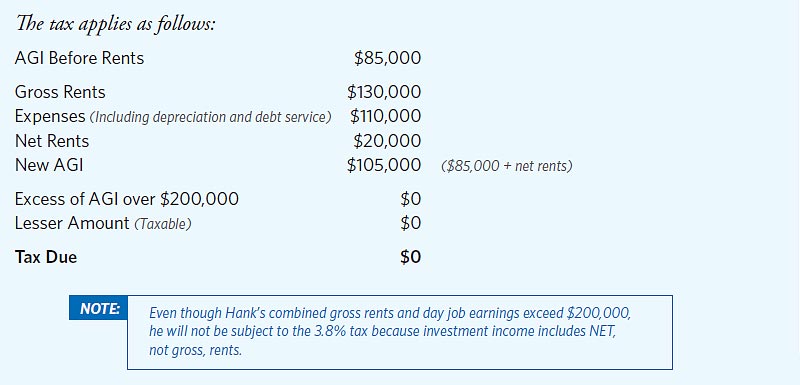
![]()
Rental Income: Rental Income as Sole Source of Earnings –
Real Estate Trade or Business
Henrietta’s sole livelihood is derived from owning and operating commercial buildings. Thus, these assets
are treated as business property and not as investment property. Her income stream is outlined below.
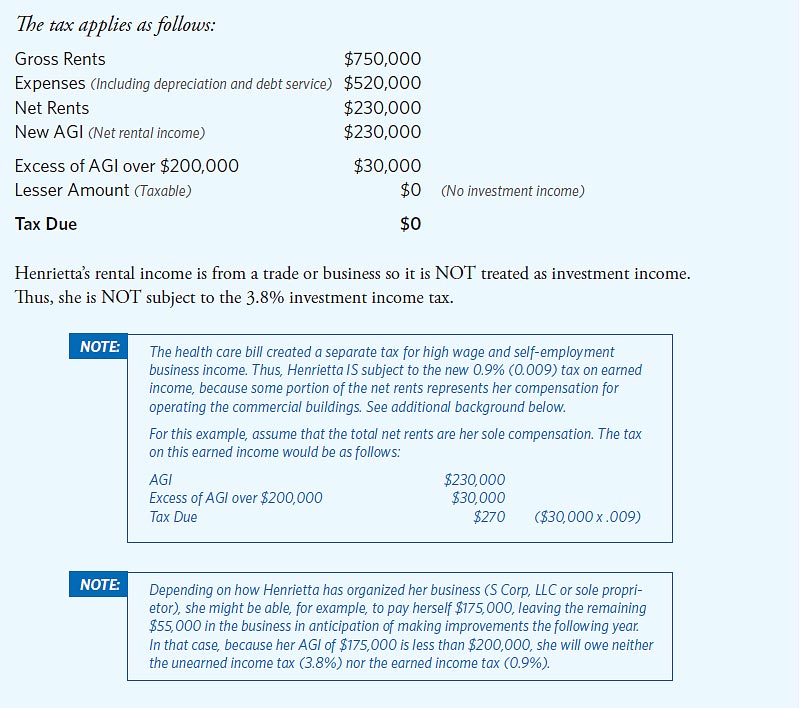
![]()
Sale of a Second Home with No Rental Use (or no more than 14 days rental)
The Bridgers own a vacation home that they purchased for $275,000. They have never rented it to others.
They sell it for $335,000. In the year of the sale they also have earned income from other sources of $225,000.
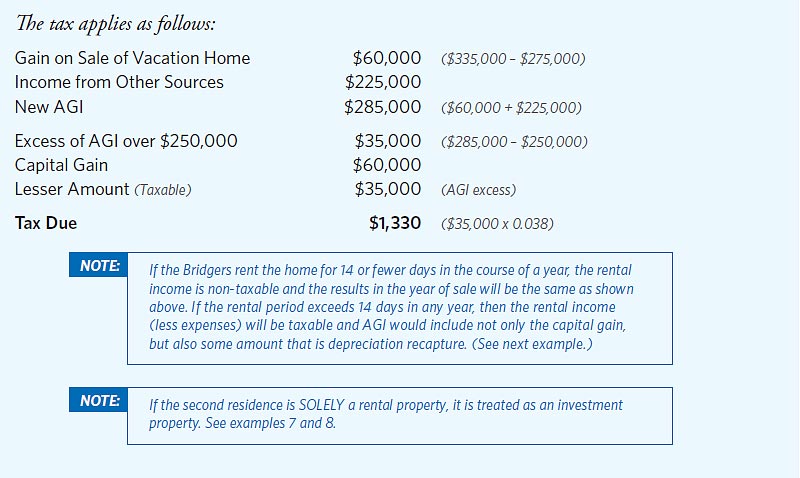
![]()
Sale of an Inherited Investment Property (Residential or Commercial)
In 2010, Ethan inherited a four-plex investment property from his great aunt. She had used it for
many years as an investment rental property in San Diego. At the time of her death, the adjusted
basis of the property was $10,000. During her period of ownership, she had taken $240,000 of
depreciation deductions on it. Its fair market value was $900,000 when she died. Because there was
no estate tax for 2010 and because carryover basis was in effect, Ethan’s basis in the inherited property
is also $10,000. The prior depreciation allowances carry over to him, as well. He continues to use
the property as an investment rental property.
Ethan later sells the property for $1.2 million. He is single and reports Schedule C self-employment
income of $180,000.
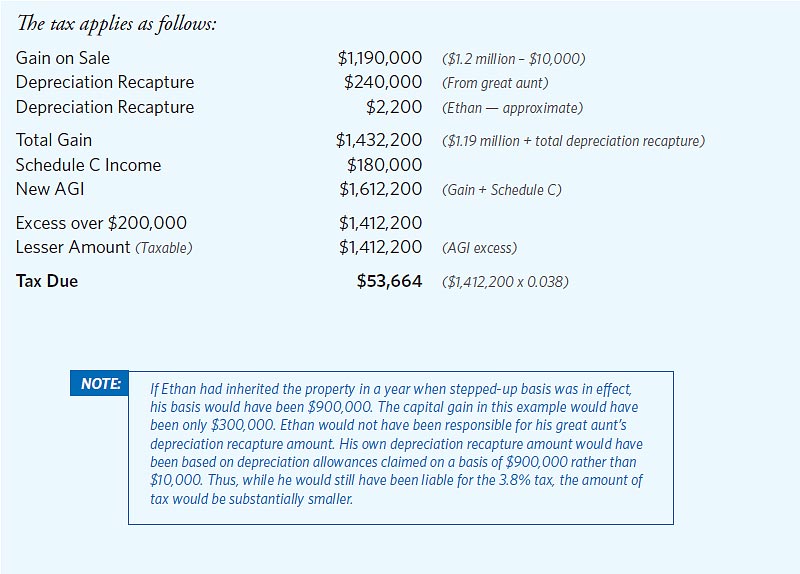
![]()
Purchase and Sale of Investment Property (Residential or Commercial)
Ethan has purchased an investment property for $900,000. During his period of ownership, he takes
$230,000 in depreciation deductions. He also made some improvements to the property. At the time
of sale, his adjusted basis in the property is $760,000. He subsequently sells the property for $1.2 million.
In the year of sale, he is single and reports self-employment income of $315,000.
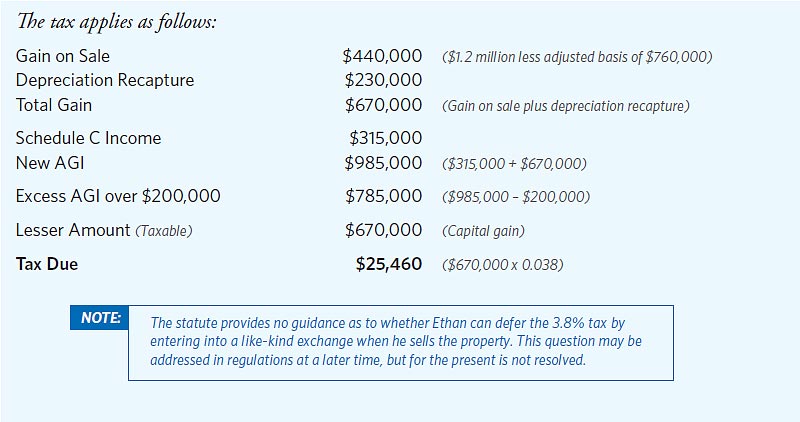
![]()
This new tax was never introduced, discussed or reviewed until just hours before the final debate on the massive health care legislation began. That legislation was enacted on March 23, 2010, more than a year after the health care debate began. This new tax was put forward after Congress was unable to agree on changes to current law that were sufficient to pay for the proposed changes to the Medicare program and increased subsidies to individuals and businesses.
The new tax raises more than $210 billion (over 10 years), representing more than half of the total new expenditures in the health care reform package. The legislation passed on a largely party line vote.
The new tax is sometimes called a “Medicare tax” because the proceeds from it are to be dedicated to the Medicare Trust Fund. That Fund will run dry in only a few more years, so this tax is a means of extending its life.
A second new tax, also dedicated to Medicare funding, is imposed on the so-called “earned” income of higher income individuals. This earned income tax has a much lower rate of 0.9% (0.009). Like the tax described on this page, this additional or alternative tax is based on adjusted gross income thresholds of $200,000 for an individual and $250,000 on a joint return. Like the 3.8% tax, this 0.9% tax is imposed only on the excess of earned income above the threshold amounts. An example and some analysis of this tax is presented in Example 5 on this page.
Another way of thinking about these new taxes is to think of the 3.8% tax as being imposed on a portion of the money that you make on your money — your capital (sometimes referred to as “unearned income”). The 0.9% tax is imposed on a portion of the money you make on your labor — your salary, wages, commission and similar income related to earning a livelihood.
Summery Points about the 3.8% Tax
1.
When you add up all of your income from every possible source, and that total is less than $200,000 ($250,000 on a joint tax return), you will not be subject to this tax.
2.
The 3.8% tax will never be collected as a transfer tax on real estate of any type, so you’ll never pay this tax at the time that you purchase a home or other investment property.
3.
You’ll never pay this tax at settlement when you sell your home or investment property. Any capital gain you realize at settlement is just one component of that year’s gross income.
4.
If you sell your principal residence, you will still receive the full benefit of the $250,000 (single tax return)/$500,000 (married filing joint tax return) exclusion on the sale of that home. If your capital gain is greater than these amounts, then you will include any gain above these amounts as income on your Form 1040 tax return. Even then, if your total income (including this taxable portion of gain on your residence) is less than the $200,000/$250,000 amounts, you will not pay this tax. If your total income is more than these amounts, a formula will protect some portion of your investment.
5.
The tax applies to other types of investment income, not just real estate. If your income is more than the $200,000/$250,000 amount, then the tax formula will be applied to capital gains, interest income, dividend income and net rents (i.e., rents after expenses).
6.
The tax went into effect on January 1, 2013. If you have investment income in 2013, you won’t pay the 3.8% tax until you file your 2013 Form 1040 tax return in 2014. The 3.8% tax for any later year will be paid in the following calendar year when the tax returns are filed.
7.
In any particular year, if you have no investment income (such as income from capital gains, rents, interest or dividends), you’ll never pay this tax, even if you have millions of dollars of other types of income.
8.
The formula that determines the amount of 3.8% tax due will always protect $200,000 ($250,000 on a joint return) of your income from any burden of the 3.8% tax. For example, if you are single and have a total of $201,000 income, the 3.8% tax would never be imposed on more than $1,000.
9.
It’s true that investment income from rents on an investment property could be subject to the 3.8% tax. But: The only rental income that would be included in your gross income and therefore possibly subject to the tax is net rental income: gross rents minus expenses like depreciation, interest, property tax, maintenance and utilities.
Questions?
Contact THE O’NEIL TEAM at 760-237-0352 or Sean@OneilRealty.com